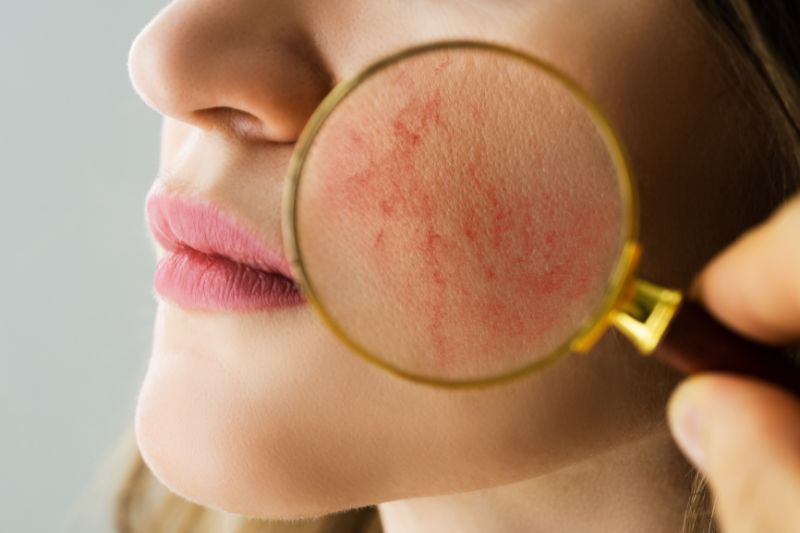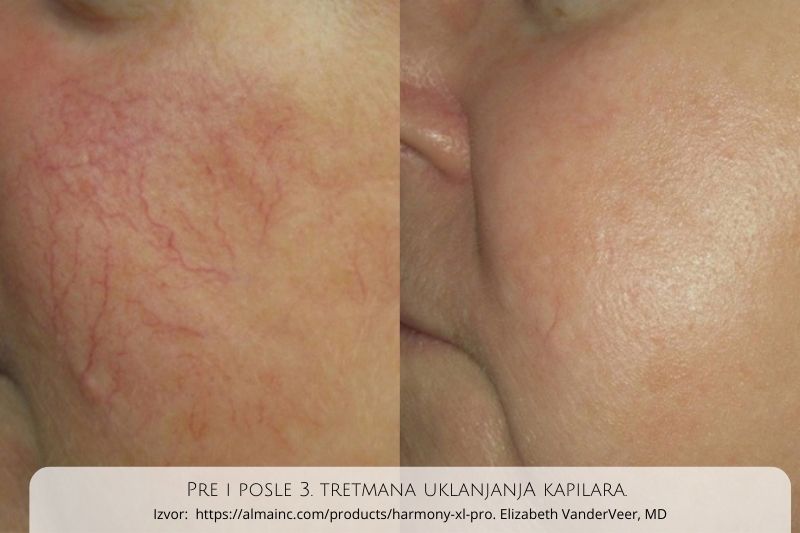Capillaries that are dilated and visible on the surface of the skin represent a major aesthetic problem. The most effective and safest way to remove capillaries is with modern lasers of the Harmony XL PRO platform.

What are capillaries?
Capillaries are the smallest blood vessels in our body, that is, the smallest parts of the circulatory system. Their role is great: they enable the exchange of substances between small arteries and small veins, but also help regulate body temperature. Depending on the tissue in which they are located, capillaries are divided into three groups:
- Continuous capillaries are those found in nerve and muscle tissue;
- Sinusiodal capillaries enable the communication of red and white blood cells, they are located in the liver and spleen;
- Fenestrated capillaries are found in the kidneys and have numerous pores (fenes) that allow passage of larger molecules.
Capillaries are located just below the surface of the skin. Dilated capillaries are professionally called telangiectasias and can appear both on the face and body, most often on the legs. They look like branching lines that can be seen through the skin.
Types of dilated capillaries
There are two types of dilated capillaries:
- primary dilated capillaries are most often of the hereditary type and occur in precisely limited areas;
- secondary dilated capillaries occur as a result of various skin damages, such as harmful UV radiation, cold, often as a result of sitting or standing for a long time. They can also occur due to taking certain medications or as a consequence of various diseases (cirrhosis of the liver, scleroderma).
Dilated capillaries most often appear on the face, arms and legs.
Why do dilated capillaries occur?
Capillaries, that is, a visible capillary network, appears in both women and men, most often after the age of 30. When it comes to the face, capillaries most often appear on the chin, nose, and cheeks. The walls of the capillaries are very elastic and if they expand suddenly, they can crack and become visible on the surface of the skin. There are several factors that influence the expansion of capillaries.
Genetics
As with any segment, the genetic factor plays an important role in whether someone will have dilated capillaries or not. If this is symptomatic in your family, there is certainly a risk that you will have the same problem, so act on time.
Hormonal changes
Hormonal imbalance is especially a problem for women, most often during pregnancy and menopause. Due to sudden hormonal changes and excess estrogen, surface vascularization of the skin appears – the skin is transparent, blood vessels are easily visible. Also, if the skin is very sensitive or dehydrated, the tissue is therefore thinner, and the capillaries break and expand more easily.
External factors
Exposure to wind, cold, harmful solar radiation, sudden changes in temperature, all this leads to changes in the skin and in the skin. The protective function of the skin is impaired, the capillaries expand and the so-called “capillary tan” appears on the skin. Injuries to the skin or aggressive squeezing of pimples can also cause capillaries to dilate.
Medicines
Taking certain medications, such as steroids or hormone therapy, can often lead to the expansion of the capillary network and the rupture of capillaries.
Consequence of illness
Due to problems with circulation and when there is poor blood flow in the veins, the capillaries break and expand more easily. The capillary network also expands as a result of certain diseases, most often as a result of liver disease.
Lifestyle
Sitting or standing for too long, unbalanced diet, smoking, alcohol consumption, lack of physical activity – these are all factors that can indirectly affect the appearance of capillaries. Obese people are also at greater risk of ruptured capillaries, as well as varicose veins. Capillaries can also be the result of aggressive treatments or improper massages.
Capillaries and couperose
Increased redness on the skin and expansion of small surface capillaries located in the demis is called couperosis. People with fair skin and sensitive skin are most often prone to couperose. Blood vessels are visible on the surface of the skin in the form of bright red to purple-blue marks. It most often appears on the nostrils, cheeks – especially the cheekbones, but the whole face can be affected. Depending on the stage of the disease, couperosis can be accompanied by itching, pain, and even inflammation of the skin.
Laser capillaries removal
Depending on how wide the capillary network is, whether it is smaller or larger capillaries, different therapies can be applied. It can be taking certain medicines to strengthen and narrow blood vessels, wearing a compression stocking. However, the most effective method that is successfully used all over the world to remove enlarged capillaries on the skin is laser therapy.
The biggest advantages of laser treatment of capillaries are the following:
- treatments with modern lasers are effective, fast and completely safe;
- laser removal of capillaries is almost painless, and the results are visible immediately;
- there is no recovery period and patients immediately return to their daily duties;
- the results are permanent.
Laser treatment of capillaries is based on photocoagulation of changed small blood vessels, with permanent removal of the resulting changes. After consultation with our doctor, we determine the capillary removal protocol – which laser we will apply, how many treatments are necessary, and at what intervals we will perform the treatments. For the capillaries removal, we use lasers that are part of the modern medical platform Alma Harmony XL Pro. Using this advanced technology, we successfully treat as many as 65 dermatological indications, including capillaries.
DYE VL laser for capillaries removal
DYE VL is an ideal laser treatment for removing small capillaries on the face and body. It also successfully removes hyperpigmentation, treats couperosis and rosacea, but also restores skin elasticity and rejuvenates it. It is a non-ablative laser that penetrates deeper layers of the skin, but the surface of the skin remains intact. The treatment is based on advanced fluorescent technology – a perfected form of IPL, intense pulsed light. The light emitted by the laser is absorbed by the hemoglobin in the blood vessels. In this way, the capillaries gradually narrow, they disappear and are no longer visible on the surface of the skin. This type of phototherapy breaks down the accumulated melanin in the skin, which leads to the disappearance of spots and an even complexion.
- Dye VL laser treatment is almost painless, with a mild stinging sensation that is tolerable;
- There is no recovery period or side effects on the skin;
- We perform treatments from autumn to early spring, when there is the least UV radiation and the possibility of hyperpigmentation is less;
The number of required treatments depends on the condition of the skin, but most often it is 3 to 6 treatments that are done at intervals of 3 to 4 weeks. Learn more about the DYE VL laser here.
ND: Yag laser for capillaries removal
The full name of the laser is Cooled Long Pulse 1064nm Nd:YAG, and this module effectively performs coagulation of vascular lesions and soft tissues. It emits intense light that successfully treats various indications, including: dilated capillaries, reticular veins with a diameter of up to 4 mm, rosacea, hemangiomas, warts. The light of the ND:YAG laser acts on the hemoglobin in the blood, the blood clots and the dilated capillaries close. We achieve excellent results in the treatment of larger visible capillaries (up to 3 mm) as well as visible veins.
The treatment is not painful, except for a slight stinging sensation, which patients tolerate well. The number of treatments depends on the expression of the capillary network, and with several treatments we achieve excellent results. The appearance of redness is possible, which passes in a day or two, and after that the skin is visibly renewed, and the complexion is even.

How long does recovery take?
No special recovery is required after laser treatment of capillaries. The redness goes away after a day or two, and during that period you should not wear make-up or expose your skin to sunlight. In order for capillary removal to be more effective, it is important to follow your doctor’s advice. This means wearing a cream with a high SPF factor, effective skin care, as well as eliminating factors that lead to the appearance of capillaries.
How many treatments do I need?
The number of necessary treatments and the treatment protocol will be determined by the doctor.
Contraindications
Capillary laser treatment is not intended for pregnant women, nor patients with malignant diseases, epilepsy, vitiligo, active skin infection. Also, this type of therapy is not for patients who use certain drugs, including anticoagulants or photosensitizing drugs.
Capillary removal – additional questions and prices
Dye VL and ND:YAG lasers are available in our office. See the prices of all services on the Pricelist page. For any additional questions, call us at 060/345-0304 or write to us at estetikabgd@gmail.com.
